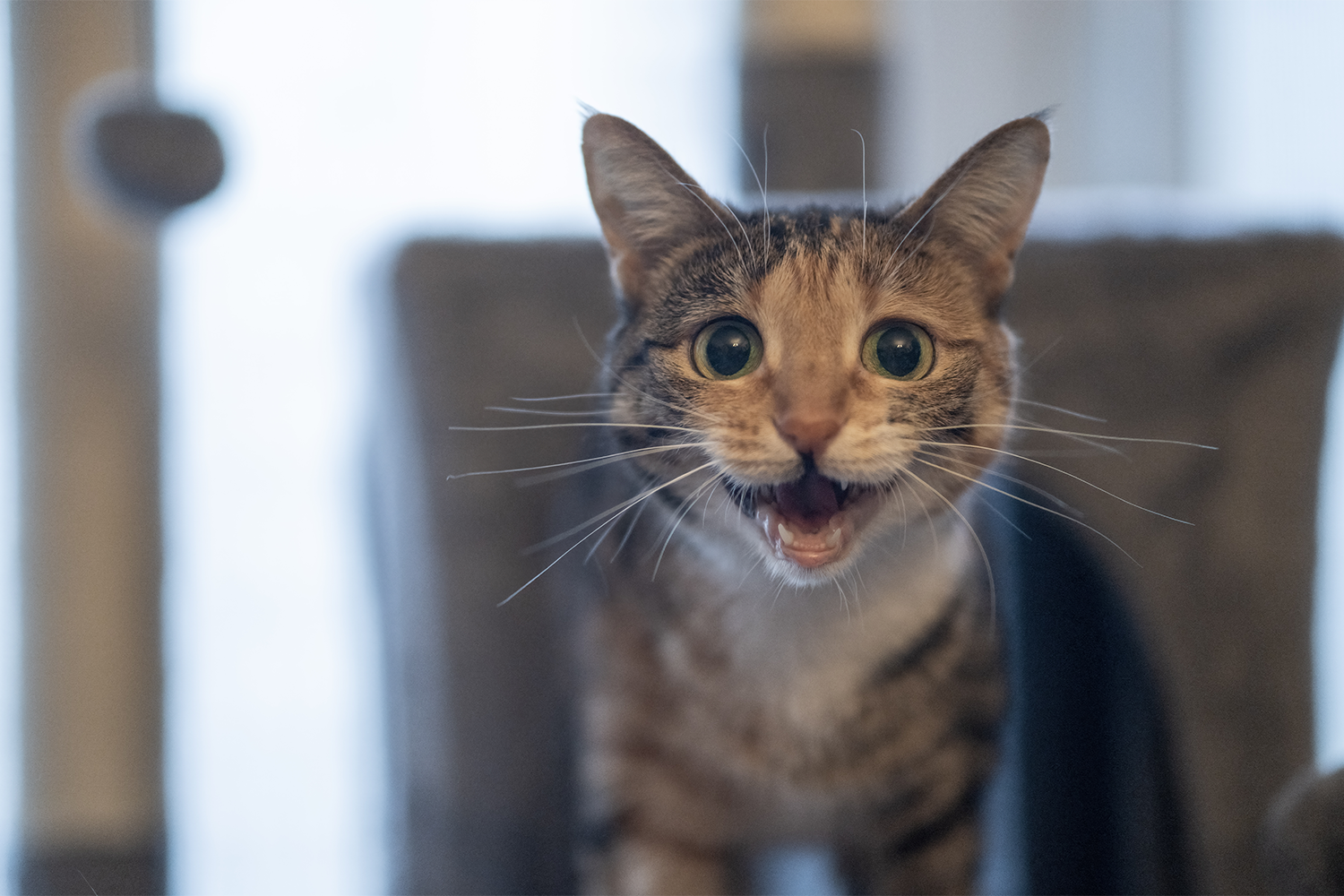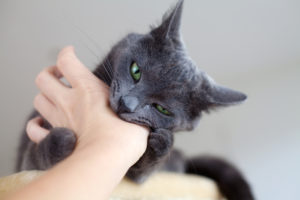Our pets have many ways of communicating with us to get what they want. If you have a cat, you’ve probably heard them meow at you to let you know it’s dinnertime or purr as you’re petting them. But have you ever been stumped by a trickier-to-decipher sound? Do you wish your cat came with a translation dictionary?
Join us as we discuss the meanings behind cat sounds and body language and figure out what your cat is trying to tell you.
Decoding Your Cat’s Body Language
Cats aren’t able to use facial expressions in the same way that dogs do, so instead, they rely on vocalizations and body language to communicate their needs. Anything from your cat’s posture to their vocalizations can tell you what mood they’re in and might even be a signal that they aren’t feeling well. Perhaps your cat is trying to tell another cat to back off. But how do you know which is which?
Let’s explore a few typical cat behavior and body language :
Rubbing and Kneading Objects
Kittens knead when nursing. As they get older, kneading becomes something they do when they’re happy, and they will usually do it against a soft surface such as a pillow or blanket. This is affectionately referred to as “making biscuits” in the cat parent community.
What about rubbing? Cats tend to rub against objects to mark their territory and spread their scent. They may do this with most objects in your home, including rubbing against you and your clothes — they want all the other cats in the neighborhood to know that you are spoken for!
Arched Back
When your cat arches their back, it can mean several things. If their fur is flat and their back is arched when you are petting them, this means that they want to be pet — they’ll probably start purring in this position.
On the other hand, if their fur is raised while their back is arched, they could be trying to make themselves appear larger and more threatening because they are scared or angry.
Tucked Tail
If their tail is tucked between their legs, it’s usually a sign that they are anxious.
Swishing Tail
While a dog wagging their tail is happy, a cat swishing their tail is typically angry, especially if their tail is moving quickly. It can also represent general excitement, like before pouncing on their favorite toy.
Airplane Ears
When your cat’s ears are flat, facing sideways and backward, this is often referred to as “airplane ears” because it resembles the wings of an airplane. It occurs when they are feeling irritated or angry.
Common Cat Sounds and Their Different Meanings
Your cat may use a variety of cat noises along with body language to communicate with you. Some of these coincide with the cues mentioned above.
Here are a few sounds that you might hear often:
Caterwaul
This is a noise that female cats use to let male cats know that they are prepared to mate. It is a moaning sound associated with being in heat.
Hissing, Howling, and Growling
These three sounds can all indicate that your cat is in pain or feels threatened. They might make these noises in the presence of new cats, other animals, or people. A hissing or growling cat feels unsafe or distressed.
Howling could also mean that they feel threatened or are trying to alert you to an illness or injury. If you notice that they begin to howl frequently, you should have them examined by your veterinarian as soon as possible.
Repeated or Short Meows
Also called chirrups or mews, this meow sound can mean that your cat is greeting you. They are excited to see you, and they want your attention right away.
Yowl
This type of meow is used when cats experience pain from something short-term, such as having their paw or tail stepped on. A yowl can let you know that they are hurt, but it typically isn’t used to express pain from a long-term injury.
Chirp
When cats see something they are excited about but don’t have access to, they chirp because they are frustrated and excited. Domestic cats might chirp when they see small animals that they consider prey from their perch near your windows, such as a bird or mouse.
Trill
Mother cats trill to get the attention of their kittens. Later on, your cat may mimic this to get your attention.
Adult Cats and Kittens: What’s the Difference?
Adult cats communicate differently than kittens because adult cats are more mature and employ a broader range of sounds. Now that you know what sounds an adult cat might use, are you curious about how these differ for kittens?
Let’s learn more:
Mother Cat’s Bond
Kittens learn the sounds their mothers make when they are born. Early on in life, they can recognize their mother’s sounds and tell them apart from those of other mother cats.
This is a crucial aspect of bonding between the mother and her kittens. Until they are old enough to be separated from her, the kittens rely on their mother’s sounds to communicate.
Since kittens learn their mother’s sounds almost instantaneously, she can tell them when she is near, discipline them, and signal that she is ready to feed them. Additionally, they can ask her for attention or comfort by crying.
The mother’s sounds are distinct to them; kittens will easily be able to discern them from those of other cats. So how does this instinct remain with them throughout adulthood?
Adult Cat Communication vs. Kitten Communication
Although adult cats have an expanded vocabulary compared to kittens, there are some sounds that they might continue to use once they reach adulthood.
Some speculate that they might do this simply because it feels comforting. Or, it might be a cause and effect — your cat discovered that certain sounds are effective in getting your attention in the same way they used them to beckon their cat mom.
Here are a few ways adult cats and kittens might use similar sounds to express their needs:
Meow
Meowing is one of several sounds that kittens mimic from their mother. Since adult cats don’t need to communicate directly with other cats by using this sound, they mainly use excessive meowing on their pet parents or other people to get attention. Through years of living with people, cats learned how to communicate with us, which is pretty darn impressive.
Yowl
Adult cats respond to pain by yowling, and kittens could do this as well. You might hear a small kitten yowl if their siblings get too rough during playtime or when they experience any other type of short-term pain.
Hissing
Just like adult cats, hissing might be a sign that a kitten feels scared or uncomfortable. It’s a real “stay back” sound.
There’s an interesting point to make here about feral cats vs. stray cats. Stray cats are those who are used to people and may have lived indoors but are now lost from their original families.
Feral cats have never lived with people, and it can be challenging to acclimate them to humans and domestic life. Feral kittens will hiss and be fearful of people, just like their mother cat.
However, note that kittens born to lost house cats or feral cats can become healthy, happy house cats as long as they experience human contact under the four-month mark.
Growling
Growling is similar to hissing. Kittens may growl to show they feel threatened, but this sound can also be used during playtime. Sometimes kittens might growl to exert dominance over siblings in a playful manner, such as when they are fighting over their favorite toys.
Kittens start socializing with their feline brothers and sisters around four to seven weeks old. Play is an important part of their development and how they learn to interact with other cats, including positive play fighting.
Chirp
Adult cats chirp when they are excited about prey that is out of their reach, but kittens can use this to express excitement too. As with most sounds kittens make, they could use it to get their mother’s attention.
What If My Cat Is Extremely Vocal?
Some cats tend to be (adorable) chatterboxes. If your cat has the gift of gab, here are a few questions to ask yourself:
Is Your Cat Hungry?
If your cat is extremely vocal, it is best to figure out the root cause, as there are many possibilities for this cat behavior. If your cat purrs or flat-out meows to beg for cat food or get attention from you, you can gently discourage this behavior.
For example, you could refrain from giving them food when they beg; this will help them understand that being quiet = getting food.
However, if your cat is on a diet and begs for more in their food bowl because they aren’t full, you might want to discuss this with your vet and consider making adjustments.
Are They In Pain?
If pain is the reason for this behavior, you should take them to the vet. When your cat is meowing to tell you they are hurt, they may stop when they are feeling better after their injury or illness is properly examined and treated.
Are They Expressing Emotions?
Cats express emotions through vocalizations, and if you spend an extended amount of time away from home without them, they might be lonely. One thing that might help is to hire a pet sitter who can play with them so they won’t feel isolated.
Playing with your cat when you return is a task we all love, so that’s an easy choice to make. You can also make sure that your cat has toys or enrichment activities while you’re out and about.
Other Reasons for Vocalization
Aside from using their wide range of vocalizations to express their everyday needs, there are other common reasons your cat might vocalize that require medical attention.
Reproductive Behaviors
If your cat hasn’t been spayed or neutered, you might notice that they exhibit certain behaviors, including being more vocal than normal. Female cats may show more affection towards you and become vocal while in heat.
Consequently, male cats typically become more vocal when they can sense a female in heat nearby.
Medical Needs for Elderly Cats
Elderly cats who begin to meow more than usual could be trying to tell you that they are in pain. It is important to stay up to date on your cat’s vet visits, even when they’re young. This can help them grow up healthy and keep an eye out for potential health issues.
If you have an elderly cat, you should have them regularly examined to keep an eye out for age-related conditions like arthritis, diabetes, or cancer. Your vet can help you provide them with appropriate care.
Noisy Cats: What To Do and What They Need
When your cat is vocal, they’re simply giving you a heads-up that they want or need something.
You will likely be able to figure out what they need as long as you pay attention. After all, no one knows your cat better than you do!
Of course, sometimes your cat screaming for attention at 3 AM when you have work at 7 is not an ideal situation for you (or for your neighbors).
In that case, there are a few steps you can take:
- Clean their litter box before going to bed (cats hate a dirty litter box)
- Place nightlights around your home (helpful for older cats)
- Ignore them to the best of your ability (acknowledging them is a kind of positive reinforcement for them)
If your cat is hissing or growling at a new cat or other pet, reach out for professional help to help your whole family (fur-babies included) get along famously.
Because Your Cat Can’t Talk For Themself
We love our cats, but sometimes it can be hard to figure out what they want or need. Whether you’re looking for advice for your feline friend, fish, puppy, lizard, or more, AskVet is here to help.
Sign up on the AskVet app to get advice and a personalized pet care plan for any animal member of your household. For only $9.99 a month, you can get all the support you need from experts veterinary professionals and pet trainers, and the AskVet Clubhouse.
Sources:
The Cat’s Meow | The Humane Society of the United States
How Do Cats Communicate With Each Other? | Library of Congress







